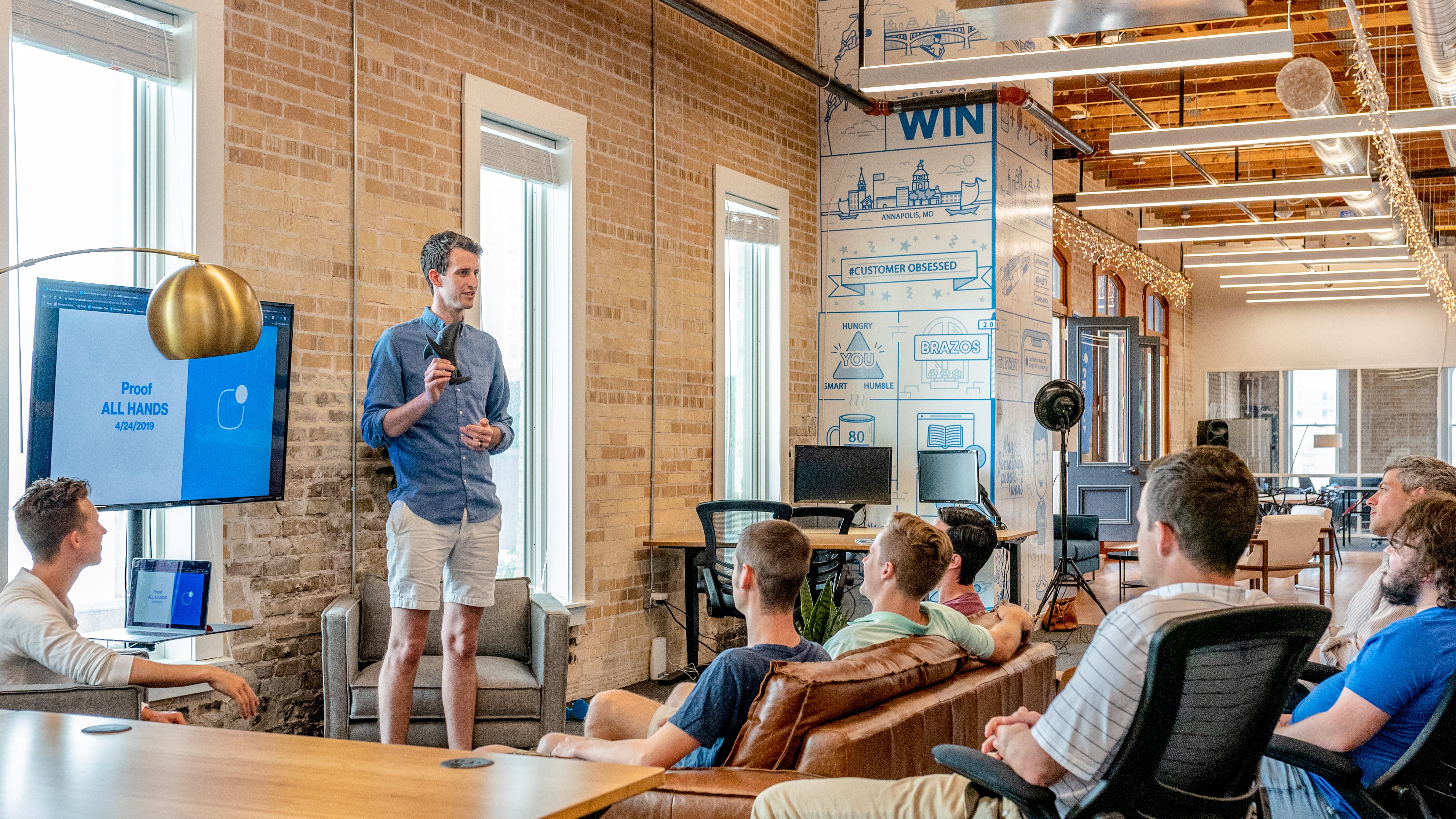Overturning a Man’s World: How Coworking Supports Women

Photo credit: Elena Mishlanova via Unsplash
In business leader Sheryl Sandberg’s bestselling book Lean In, she recollects a time when she was pregnant and couldn’t find a vacant parking space near the entrance of the Google headquarters where she worked. Sandberg requested her male employers immediately implement “designated parking for expectant mothers at the front of each building,” but she wouldn’t have been the first pregnant woman working at Google. She wondered whether her female coworkers hadn't felt comfortable calling it out.
Women have historically been underrepresented in the workplace. This was cleverly depicted in this summer’s phenomenal Barbie film when manufacturer headquarters Mattel had a clear absence of women working at the top. For a company that was originated by a woman, making products for women, it seems unbelievable. Sadly this representation isn’t a million miles off what the corporate world used to look like (as Sandberg can attest). The needs of women at work are commonly overlooked in a male-dominated world.

Photo credit: Austin Distel via unsplash
Coworking, it’s a man’s world…
When coworking entered the working realm well over a decade ago, the playful look, feel, and culture of coworking set it apart from traditional corporate offices. It brought an expectation that coworking was reversing notions of the patriarchal corporate world. This was reflected in its workspace design, an example being the “Superdesk” – a long, curved desk to seat 175 people designed by Clive Wilson. A round table is representative of inclusivity.
But then the beer tap came along. Free unlimited alcohol on demand allows workers to tap out of a stressful work day and enjoy one or two drinks before leaving the office. Its unlimited source, however, encourages more than one or two. Excessive drinking is problematic and led certain coworking spaces to become synonymous with “bro culture.” The beer tap was a symbol of patriarchy at work if ever there was one. A notable workspace operator has experienced multiple incidents of sexual harassment and assault as a result of an unlimited supply of alcohol on demand.
It also begs the question – Were women ever involved in the design processes of those shared workspaces? Possibly not. That’s where the problem lies. Not listening to the requirements of women contributes to a world that’s designed by men, for men. “The blunt truth is men still run the world. This means that when it comes to making the decisions that most affect us all, women’s voices are not heard equally,” expresses Sandberg.
A coworking space isn’t going to be used by women if we don’t feel it’s designed for us. To create inclusive workspaces for women, operators must listen and understand what women want (pun intended).
Steps into our shoes
Shazia Mustafa is the Centre Director for the Granville – an affordable workspace for the South Kilburn community, and co-founder of Third Door – the UK’s first coworking and flexible nursery hybrid Ofsted registered business. Discussing diversity, equity, and inclusion in coworking at the Workspace Design show earlier this year, Mustafa recommended that operators who are designing workspaces inclusive of women start with bathrooms.
“Toilets are important,” she says, and bear in mind that women feel the cold at a lower temperature than men. The average temperatures of AC units are set to male preferences (the first air conditioning unit was designed in 1902 by US engineer Willis Haviland Carrier). In her revolutionary book Invisible Women, feminist writer Caroline Criado Perez explains that women are “shivering in offices set to a male temperature norm, for example, or reaching a top shelf set at a male height norm.” Her book continues to expose a significant gender data gap that’s exemplified by the size of your phone, the design of your uniform, workplace safety regulations, and many more.
Mustafa says: “When I set my coworking space up for working parents, it was 2008 before anyone knew what coworking was. I set it up from the viewpoint of a mum.” Similar to Sandberg’s experience at Google, Mustafa faced new challenges when becoming a mother. She recollected how even walking around London became much more challenging when using a pram. She then became aware that people with disabilities must also struggle to navigate the city. Sometimes, it’s only when we have first-hand experience that we truly understand the needs of others. That’s why it’s so important to involve women in the design process. You can design a workspace around our needs, one which instantly is more inclusive of, and more usable for and by women.

Photo credit: Sandy Millar via Unsplash
Women in flex
It’s important to think about women at all life stages too, as women who are just entering the workforce will have different needs than mothers, menopausal women, or older women who struggle with their mobility, for example. Applying a one-size-fits-all approach doesn’t work. Staying flexible does. By its very nature, coworking is flex. It embraces flexible working lifestyles. That’s why there’s no fixed agenda, no mandated start time, or clocking in how many coworkers walk through the doors. It’s completely up to individuals to decide when they’d like to use it. This approach works for many companies. Last year, 12% of UK businesses were seeking coworking spaces over leasing their own private offices, reports Mordor Intelligence.
The coworking industry expects to see an 8% compound annual growth rate between 2022-2027. It’s a shift that most people welcome, especially women. “Female employees who are able to work how they want are less burned out, happier in their jobs, and much less likely to consider leaving their companies,” reveals the findings of the Workplace Health Report 2023 on the mental health of the UK workforce.
Its research also discovered that only 1 in 10 women actually want to go into the office. They’re attracted to organisations that support remote working, which might be because women are typically the default caregiver for their children and elderly parents. Commuting for 90 minutes a day (the average commute time) becomes impossible for women with fragmented time. Meanwhile, a local workspace gives parents an opportunity to leave home but be right around the corner if they need to pop back.
Local workspaces are one of several coworking industry trends in high demand by women, amongst other intersectionalities. This is important too - there are many more needs to consider when creating inclusive workspaces. Nonetheless, putting your community’s needs first empowers them to thrive in your workspace, as well as attracting them in the first place. By hearing their voices, meeting their requirements, and designing a workspace for them, you’re creating truly inclusive coworking communities.
And if you’re not convinced that it’s still a man’s world, I suggest you go and watch the Barbie movie!
If you’re thinking of opening a coworking space and are looking for a software solution to streamline processes, book a demo today.
Related stories
Global Coworking Trends and Opportunities for 2025
Now well into 2025, the coworking industry continues to demonstrate strong momentum. With demand for coworking spaces remaining steady around the globe, it's clear that coworking is not just enduring—it's thriving. Let’s explore the major trends and opportunities shaping the global coworking landscape this year.
Creating Events that Drive Community Engagement in Coworking Spaces
Community is everything in coworking, but a genuine sense of connection between members doesn’t magically happen overnight or by chance. Often, meaningful relationships take intentionality, effort, and time to build, with events being an effective vehicle for bringing people together around shared interests, goals, and experiences, creating opportunities for collaboration, and a thriving coworking culture. This article looks at creating events that drive community engagement in coworking spaces.
Liz Elam: ‘Community is the number one amenity in coworking spaces’
A household name in the global coworking industry, Liz Elam, is the founder of one of the world’s best coworking event series: GCUC. Liz’s coworking roots began in 2010, when she established Link Coworking – a welcoming, affordable, and professional coworking space – in her hometown of Austin, Texas. Link Coworking achieved incredible success, expanding across three locations and becoming the fourth-largest coworking brand in Austin. It was sold in 2019, making Liz the first woman globally to exit a coworking brand.
Key Takeaways from the Coworking Alliance Summit 2025
Gathering online for the Coworking Alliance Summit last week, members of global coworking alliances, coworking spaces, and community leaders came together to navigate global issues, strengthen ties across the coworking industry, and work collectively towards future goals.
5 Ways to Reduce Noise in Open Offices & Coworking Spaces
Some people like working against a background of noise, while for others it’s their worst work nightmare. The truth is, our relationship with noise depends on our own preferences and the nature of our work.
Key takeaways from the Workspace Design Show 2025
London’s Workspace Design Show is undoubtedly one of the best coworking events of 2025. For one, the exhibition (held at Islington’s Business Design Centre) features a host of innovative and creative workspace design solutions tailored to the needs of modern workplaces.
What Is Workplace Management and Why Does It Matter?
There has always been a need for workplace management – the process of organising and optimising physical spaces, resources, and operations to support people’s needs. But, as 28% of UK working adults were reported to work in a hybrid capacity last autumn (by the Office for National Statistics), the question of ‘why workplace management matters’ is more critical than ever. Let’s look at the workplace management benefits for your operations.
10 Smart Goals for your Coworking Space: How to Set & Achieve Business Objectives
Coworking is synonymous with creativity, collaboration and productivity. Businesses and freelancers love coworking spaces because (by surrounding themselves with fellow workers) they’re more likely to achieve their goals. The coworking environment, while social, is set up to facilitate focused, distraction-free working.
The Best Coworking Events in 2025: Must-Attend Gatherings for Professionals
Managing coworking spaces is an all-encompassing role, often leaving operators, owners, and community managers with little time to focus on personal growth or draw inspiration from others.
10 Award-winning Coworking Space Designs: A Comprehensive Guide
Vibrant, contemporary workspaces create an undeniable ‘wow’ factor. Textured designs and ambient lighting make spaces feel warm and cosy, while natural elements and biophilic design features have literal mood-boosting properties.

